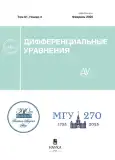Volume 61, Nº 2 (2025)
ORDINARY DIFFERENTIAL EQUATIONS
ON EXISTENCE OF PERIODIC SOLUTIONS OF AN ORDINARY SECOND-ORDER DIFFERENTIAL EQUATION WITH PARAMETER AND DISCONTINUOUS RIGHT-HAND SIDE WITH VARIOUS BOUNDARY CONDITIONS
Resumo
 147–161
147–161


ASYMPTOTICS OF EIGENVALUES AND EIGENFUNCTIONS OF THE STURM–LIOUVILLE OPERATOR WITH SINGULAR POTENTIAL ON A STAR GRAPH. I
Resumo
 162-176
162-176


 177-189
177-189


 190-199
190-199


ON A PRIORI ESTIMATE OF PERIODIC SOLUTIONS OF THE SYSTEM OF ORDINARY DIFFERENTIAL EQUATIONS OF THE SECOND ORDER WITH THE MAIN POSITIVELY HOMOGENEOUS NONLINEARITY
Resumo
 200-206
200-206


ON THE SPECTRA OF OSCILLATION EXPONENTS OF A TWO-DIMENSIONAL NONLINEAR SYSTEM AND ITS FIRST APPROXIMATION SYSTEM
Resumo
 207-220
207-220


ON THE ASYMPTOTICS OF SOLUTIONS OF ORDINARY DIFFERENTIAL EQUATIONS OF ODD ORDER
Resumo
 221-228
221-228


PARTIAL DERIVATIVE EQUATIONS
POISSON FORMULA FOR SOLVING THE RADIAL CAUCHY PROBLEM FOR A SINGULAR ULTRAHYPERBOLIC EQUATION
Resumo
 229-241
229-241


NUMERICAL METHODS
ON THE ESTIMATION OF THE EXPLICIT EULER METHOD LOCAL ERROR FOR THE NUMERICAL SOLUTION OF THE CAUCHY PROBLEM FOR ORDINARY DIFFERENTIAL EQUATIONS TRANSFORMED TO THE BEST ARGUMENT
Resumo
 242-260
242-260


BRIEF MESSAGES
 261-267
261-267


THE CAUCHY PROBLEM FOR A SYSTEM OF MOMENT THEORY OF ELASTICITY
Resumo
 268-274
268-274


CHRONICLE
О СЕМИНАРЕ ПО ПРОБЛЕМАМ НЕЛИНЕЙНОЙ ДИНАМИКИ И УПРАВЛЕНИЯ В МОСКОВСКОМ ГОСУДАРСТВЕННОМ УНИВЕРСИТЕТЕ ИМЕНИ М.В. ЛОМОНОСОВА
Resumo
Ниже публикуются краткие аннотации докладов, состоявшихся в осеннем семестре 2024 г. (предыдущее сообщение о работе семинара дано в журнале “Дифференциальные уравнения”. 2024. Т. 60. № 8; дополнительная информация по адресу iline@cs.msu.ru)
 275-288
275-288











